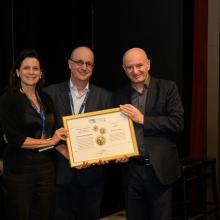The scent of compassion
Exposure to chemicals in women’s tears can reduce aggressive behavior in men
Briefs

It seems a romantic cliché: The cruel villain is moved to uncharacteristic sympathy at the sight of the distressed heroine’s tears. According to a recent study from Prof. Noam Sobel, there may be some truth to this imagined scene—but related more to scent than sight. In a new study published in December 2023 in PLOS Biology, Prof. Sobel and his group in the Department of Brain Sciences demonstrated that sniffing women’s tears lowered brain activity associated with aggression in men, thereby reducing aggressive behavior.
Why do people cry for that matter? Puzzled by emotional tearing, which appeared to have no useful function beyond lubricating the eye, Charles Darwin posited in 1872 that such tearing must have evolved in humans by chance.
That theory, however, has been repeatedly called into question. We now know that in mammals, rodents in particular, tears contain chemicals that serve as social signals and can be emitted on demand. One of the most common purposes is to reduce aggression. The tear liquid of female mice, for example, contains chemicals that affect aggression networks in the brain, thereby reducing fighting among male mice. Subordinate males of blind mole rats smear themselves in tears to reduce the dominant male’s aggressive behavior toward them.
Prof. Sobel, whose lab studies olfaction—the sense of smell— hypothesizes that human tears also contain chemicals that serve as social signals. Back in 2011, in research published in the journal Science, his team showed that sniffing women’s emotional tears reduced testosterone levels in men, resulting in diminished levels of sexual arousal.
In their new study, the Sobel group examined whether tears have the same aggression-blocking affect in people as they do in rodents. In a series of experiments led by PhD student Shani Agron, men were exposed to either women’s emotional tears or saline without knowing what they were sniffing and without being able to distinguish between the two, since both are odorless. Next, they played a two-person monetary game. The game was designed to elicit aggressive behavior in one player toward the other player, who they were led to believe was cheating against them. The male players were then given the opportunity to get revenge on the other players by causing them to lose money, though they themselves gained nothing.
After the men sniffed women’s emotional tears, their revenge-seeking aggressive behavior during the game dropped nearly in half.
This effect seemed equivalent to that observed in rodents, although rodents have a structure in their noses that picks up social chemical signals. Given that humans lack such hardware, how do they sense the social chemicals? To find an answer, the researchers applied the tears to 62 human olfactory receptors in a laboratory dish and found that four of these receptors were activated by the tears, even though tears are odorless.
Furthermore, they repeated the experiments while examining the men’s brains in an MRI scanner. Functional imaging showed that two aggression-related brain regions—the prefrontal cortex and the anterior insula—were less active when the men were sniffing the tears. The greater the difference in this brain activity between saline and tears, the less often the players took revenge during the game.
Says Prof. Sobel, “These findings suggest that tears are a chemical blanket offering protection against aggression—and that this effect is common to rodents and humans, and perhaps to other mammals as well.”
It is important to note an imbalance in the study: the researchers were unable to recruit any male volunteers to contribute tears. The Sobel lab is now extending their current study to determine how the chemical in women’s tears influences other women’s behavior.
NOAM SOBEL IS SUPPORTED BY:
-
Azrieli National Institute for Human Brain Imaging and Research
-
Rob and Cheryl McEwen Fund for Brain Research
-
Sagol Weizmann-MIT Bridge Program
-
Sara and Michael Sela Professorial Chair of Neurobiology








